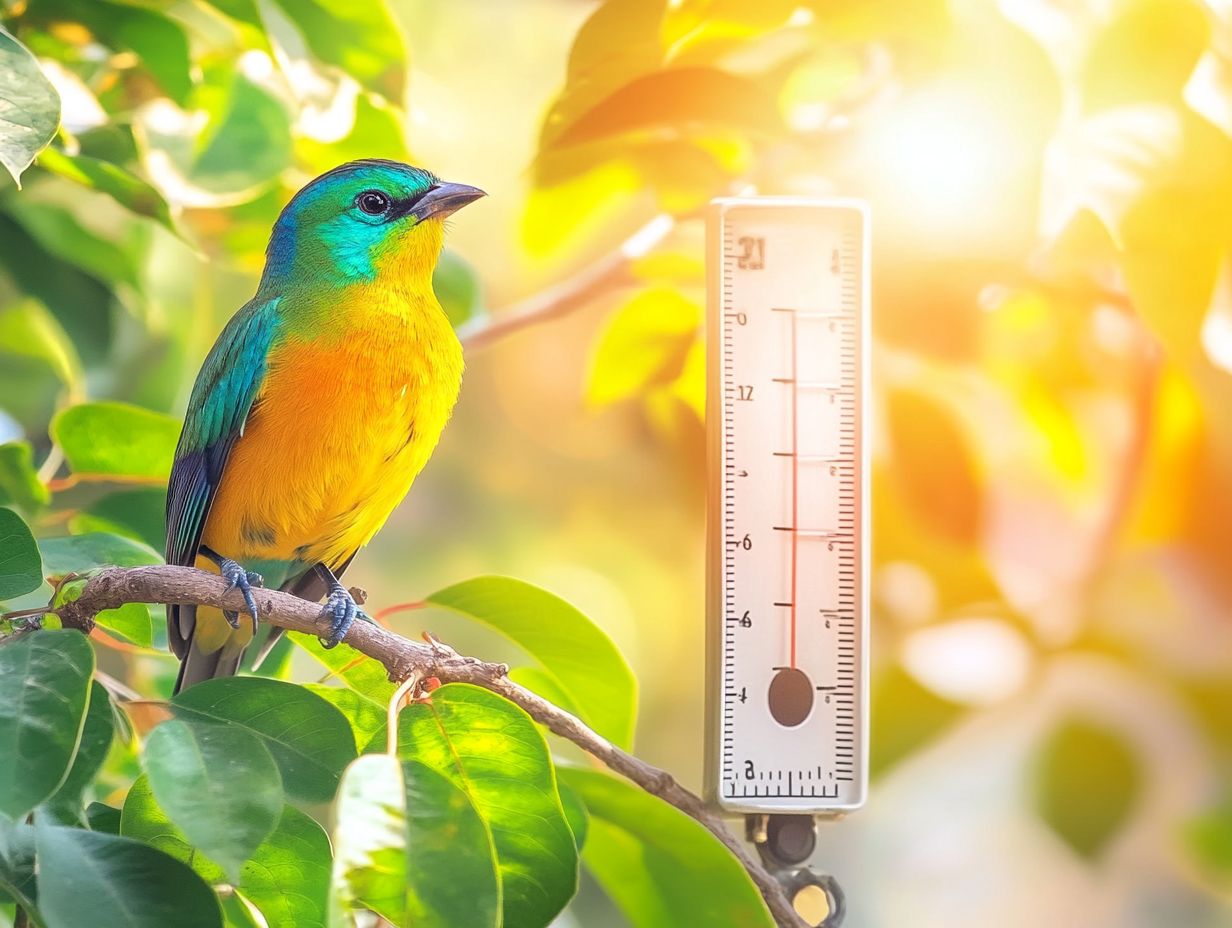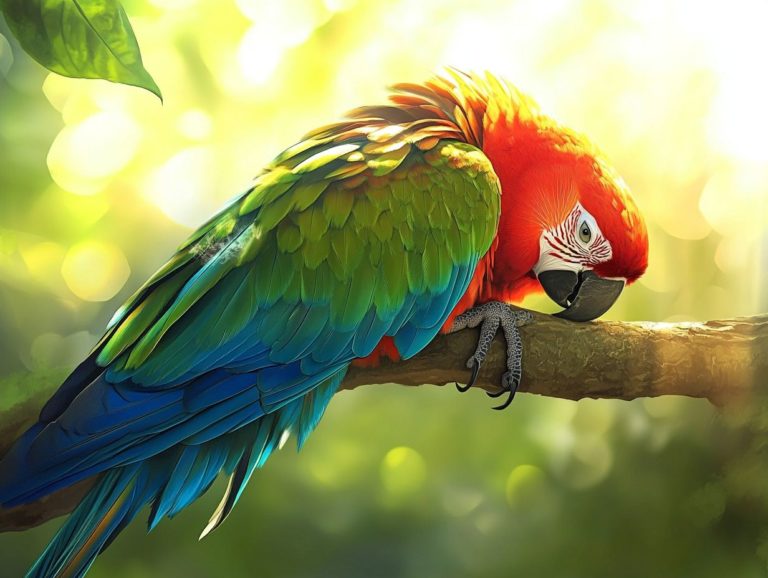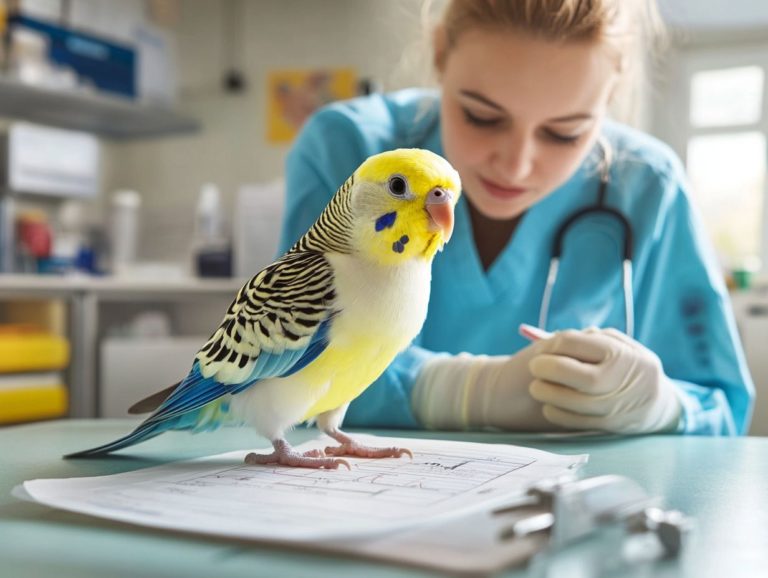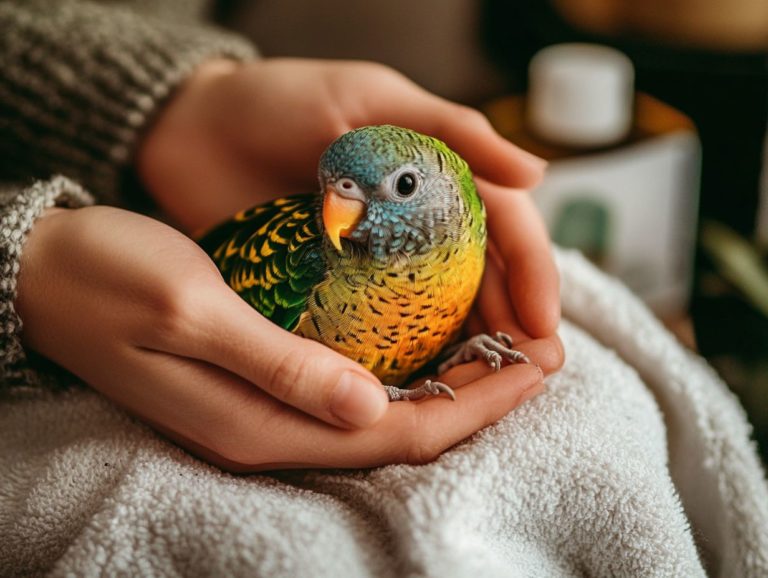The Impact of Temperature on Bird Health
Temperature is a pivotal factor in the lives of birds. It intricately influences their health, behavior, and overall survival.
Extreme temperatures both soaring highs and freezing lows can profoundly affect these remarkable creatures. Heat stress can lead to serious health issues and reduce reproductive success. Conversely, colder climates pose risks of hypothermia and frostbite that birds must contend with.
Uncover practical tips for safeguarding birds against extreme weather, as well as the long-term implications of climate change on avian populations, including the impact on North American birds.
Discover the essential link between temperature and bird health, and understand how it shapes their very existence.
Contents
Key Takeaways:

- High temperatures can harm birds, causing heat stress and negatively impacting reproduction.
- Low temperatures can also be detrimental, leading to hypothermia and affecting migration and behavior.
- Providing adequate shelter and water helps protect birds from extreme temperatures, but climate change poses a long-term threat to bird populations and contributes to habitat loss.
Why Temperature Matters for Birds
Temperature is crucial for the survival and reproduction of birds, especially due to climate change. Warming temperatures can dramatically reshape the habitats and ecological niches available to various North American birds.
Fluctuations in temperature impact not only the functioning of bird species including their ability to regulate body temperature but also disrupt their migration patterns and breeding ranges. These changes significantly affect bird populations across various environments.
Effects of High Temperatures on Birds
High temperatures threaten bird populations by leading to issues like heat stress and heatstroke. These conditions can result in declines among avian species, especially in regions experiencing drought and fire.
Heat Stress and Heatstroke
Heat stress and heatstroke are serious conditions impacting bird populations, causing elevated body temperatures that threaten their health and survival.
When birds encounter extreme heat, they respond by increasing their breathing rates and altering blood flow to dissipate excess warmth. Many species exhibit remarkable behavioral adaptations, such as seeking shade or increasing water intake.
Some birds may also change their nesting and foraging behaviors to cooler parts of the day. These strategies enhance individual survival and bolster the resilience of the entire population against climate change, highlighting the intricate relationship between environmental factors and bird adaptability.
Impact on Reproduction

High temperatures can disrupt reproductive patterns, leading to a situation known as phenological mismatch. This occurs when breeding ranges no longer align with optimal environmental conditions.
This misalignment can significantly impact nesting success and the timing of reproductive cycles across various bird species. For example, early spring breeders like the American robin may find that their primary food sources, such as insects, emerge before their young hatch, resulting in inadequate nutrition and higher mortality rates among chicks.
Similarly, species like the black-capped chickadee face challenges as warmer winters lead to earlier blooms of flowering plants, which can affect the availability of insects during critical feeding periods for nestlings.
These disruptions threaten not only individual bird populations but also have broader ecological implications, impacting community dynamics and influencing phenology across ecosystems.
Effects of Low Temperatures on Birds
Low temperatures create distinct challenges for bird species, leading to conditions like hypothermia and frostbite. This is especially pertinent for North American birds, which are finely tuned to their specific ecological niches and the environmental variations they encounter.
Act now to help our feathered friends! Consider providing birdhouses or water sources to support them in adapting to temperature changes.
Hypothermia and Frostbite
Hypothermia and frostbite pose serious threats to bird populations, impacting their ability to regulate body temperature and endure harsh environmental conditions.
As temperatures plummet, physical changes unfold within birds that hinder their normal thermoregulation, the process birds use to keep their body temperature stable. Hypothermia takes hold when their core body temperature dips below the crucial threshold required for metabolic functions, resulting in lethargy and impaired flight.
Frostbite, in contrast, primarily targets extremities like feet and wings, leading to tissue damage that may compromise mobility or functional digits. Signs of distress often manifest as shivering, increased vocalization, and noticeable behavioral changes.
These conditions can drastically affect avian survival, underscoring the importance of implementing effective recovery strategies. Providing access to warm roosting sites and ensuring appropriate nutritional sources are essential for helping birds rebuild their energy reserves.
Impact on Migration and Behavior
Low temperatures can profoundly impact the migration patterns and behaviors of birds, disrupting their natural rhythms and leading to shifts in breeding ranges and ecological niches.
As you observe these avian species confronting declining temperatures, you’ll notice many adapting by altering their migration timing departing their breeding grounds earlier or arriving later at wintering sites. For instance, the Arctic Tern has been seen adjusting its migratory route to seize warmer conditions.
Similarly, the Black-throated Blue Warbler has shifted its migration path slightly southward to escape harsher climates. These adaptations aren t simply instinctive reactions; they illustrate a complex interplay between environmental cues and the birds physiological responses.
These changes have broader ecological implications, underscoring the interconnectedness of ecosystems and the urgent need for conservation efforts to protect critical habitats along migratory routes.
How to Protect Birds from Extreme Temperatures

Protecting birds from extreme temperatures calls for proactive measures on your part. Providing adequate shelter and reliable water sources is essential for their survival in an environment that can change dramatically.
By taking these steps, you contribute significantly to their well-being in the face of fluctuating conditions and help combat the challenges posed by habitat loss.
Tips for Providing Adequate Shelter and Water
To support bird populations during extreme temperatures, it s essential for you to provide adequate shelter and reliable water sources, as these factors significantly influence their survival and reproduction, especially in the context of climate change.
One effective way to achieve this is by building birdhouses that offer comfortable nesting environments, allowing birds to thrive during challenging seasons. Consider creating gardens filled with native plants to attract various species, providing not only essential food sources but also natural cover.
Ensuring that clean water is readily available whether through birdbaths or small ponds becomes crucial during those hot summer months or freezing winter days when resources are scarce.
By taking these steps, you collectively create inviting habitats that help sustain local avian populations and promote biodiversity within your community.
Join us in protecting our feathered friends!
Long-Term Effects of Temperature on Bird Populations
Act now! The long-term impacts of changing temperatures are alarming, resulting in considerable habitat loss and shifts in ecological niches. This poses serious challenges for bird populations across diverse ecosystems.
Climate Change and its Impact on Birds
Climate change is fundamentally reshaping the distribution and behavior of bird populations. It significantly affects migration patterns and leads to habitat loss across various regions.
As temperatures rise and weather patterns become more erratic, many bird species find their traditional migratory routes increasingly compromised. For example, certain shorebird species are arriving at their breeding grounds much earlier than in previous decades, creating a disconnect with peak food availability.
This shift threatens their breeding success and endangers their overall population dynamics.
In the northeastern United States, the earlier spring arrival of the American Robin links directly to changing weather conditions. This raises alarms among bird experts regarding its long-term sustainability.
Habitat loss caused by the growth of cities and climate changes poses serious challenges for vulnerable bird populations. This necessitates a critical reevaluation of conservation strategies.
Frequently Asked Questions

1. How does temperature affect birds?
Temperature is vital for bird health! Extreme temperatures can cause stress, dehydration, and even death in birds. It can also impact their immune system, making them more susceptible to diseases.
2. What is the ideal temperature range for birds?
The ideal temperature range for most birds is between 65-80 degrees Fahrenheit. This allows them to maintain their body temperature and perform daily activities without getting too hot or cold.
3. Can high temperatures be harmful to birds?
Absolutely! High temperatures can seriously harm birds. Exposure to high temperatures can cause heat stress, heat stroke, and even death. It is important to provide shade and access to water during hot weather to prevent these issues.
4. How does temperature affect breeding and nesting behavior?
Temperature impacts the breeding and nesting behavior of birds. Some species may delay breeding if it s too cold, while others may become less active during hot weather. Temperature changes can also affect the availability of food and nesting materials.
5. What can I do to help birds during extreme temperatures?
To help birds during extreme temperatures, provide a source of fresh water, offer a variety of food options, and create shelter or shade. You can also plant native trees and plants that serve as natural shelters for birds.
6. How does temperature impact migratory birds?
Temperature can greatly impact migratory birds, as they rely on temperature cues to know when to start their journey. Changes in temperature can disrupt their migration patterns and affect their ability to find food and shelter along the way.






